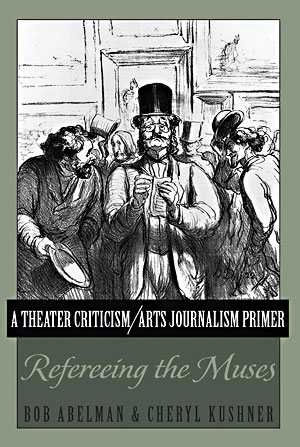
By Bob Abelman and Cheryl Kushner, Peter Lang Publishers, New York.
Arts journalism has changed, but the fundamentals of good criticism have not. Those of us who lament the paucity of informed, long-format criticism and the rise of ephemeral opinion could complain about lost values—or we could pass out copies of A Theater Criticism/Arts Journalism Primer: Refereeing the Muses, a new book by Ohio-based critic-scholars Bob Abelman and Cheryl Kushner.
Over the course of 271 pages, Refereeing the Muses makes the case for arts criticism at large, and provides the tools for budding critics to navigate their field. Structured like a textbook with abstracts, bullet points, copious endnotes and more than 40 case studies, it covers the roles and responsibilities of critics and the history of theatre criticism within a condensed history of theatre. The advent of “instant criticism,” readers may be surprised to discover, did not come with Twitter, but with the turn of the 20th century, when newspapers intent on scooping one another began publishing reviews written hurriedly for their morning editions.
The book also moves right into the present, describing the effect of new media (yes, Twitter) and how some of today’s best-known American theatre critics—David Cote, Ben Brantley, Terry Teachout—prepare and execute their craft. But the foundation for the dialogue in this book is based on the classics, from Plato and Aristotle to Francis Bacon. Attention is duly paid to methods of critical thinking (“theatregoers think, critics engage in critical thinking,” the text emphasizes), ways to approach criticism, and how to deconstruct a review, so the lessons of the book could as easily apply to critical writing about art, music and dance as they do to theatre.
Any document that attempts to outline a process for thinking about a particular subject risks scholarly over-codification, but Abelman and Kushner avoid that pitfall by acting more as reporters gathering information than as scholars arguing a thesis. For instance, their account of the evolution of theatre criticism—which could double as the history of journalism—comes without commentary from the authors; the only trace of their points of view is in their decision of which voices of the past to include. So when we read that a particular critic’s opinion is presented “with the sense that any other proposition is incorrect, woefully misguided and must be corrected,” we feel free to think something like, “But that’s why people hate critics!” rather than faulting the authors for being judgmental. (On the other hand, the book does betray some mild hostility toward jukebox musicals.)
What seems clearest about the authors’ perspective is their belief that critics should not be limited to narrow or dogmatic ways of thinking. Abelman and Kushner carefully chart the range of contextual possibilities for critics, moving away from the idea that the purpose of criticism is to evaluate the performance alone, for the posterity of the cast and crew or the convenience of readers trying to plan their cultural activities—though that’s certainly part of it. Of their four critical contexts for engagement—genre, auteur, sociological and anthropological—the first two deal more with aspects of theatre and production, while the latter two look at the historical context for the material.
Experienced critics might wonder why such a book hasn’t been written before. Arguably, the chapters on how to write criticism are basic journalism—techniques I hope J-school students are learning regardless—and many of the lessons in the book can just as easily be learned through trial and error. The very best advice in the book is the reiteration of Harold Clurman’s “The Complete Critic’s Qualifications,” which include, among other things, knowledge of classic and contemporary drama, literature, theatre history, world history, philosophy and ethics.
A critic should be generous and should hold herself, as well as her readers, to high standards. She should also know how to write. Of course, Clurman didn’t live in a time, as we do, when one of the world’s largest media companies, Condé Nast, has suspended its internship program, and only a select few make a living from criticism alone. The opportunities for practice and mentorship are few, so a book like this can point novices in the right direction.
In some ways, Refereeing the Muses is not for critics at all, but for theatregoers. Critics practice criticism because they love it, and they will find ways to do it well. But readers might not know how much more there is to a serious review than thinking. There’s critical thinking, which doesn’t get much play in 140 characters.
Matthew Irwin (matthewjirwin.com) is an itinerant freelance arts writer. This is his first piece for American Theatre.

